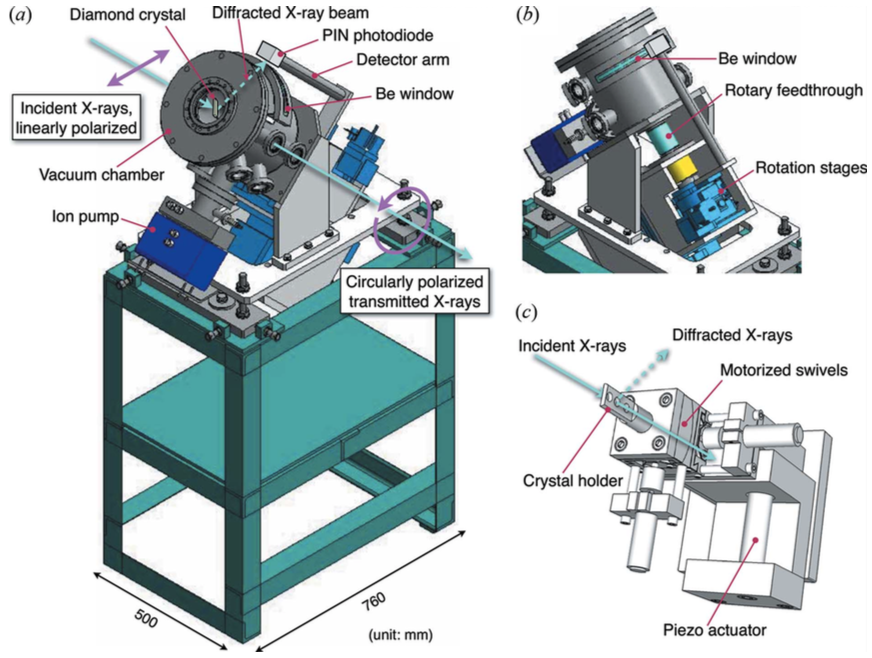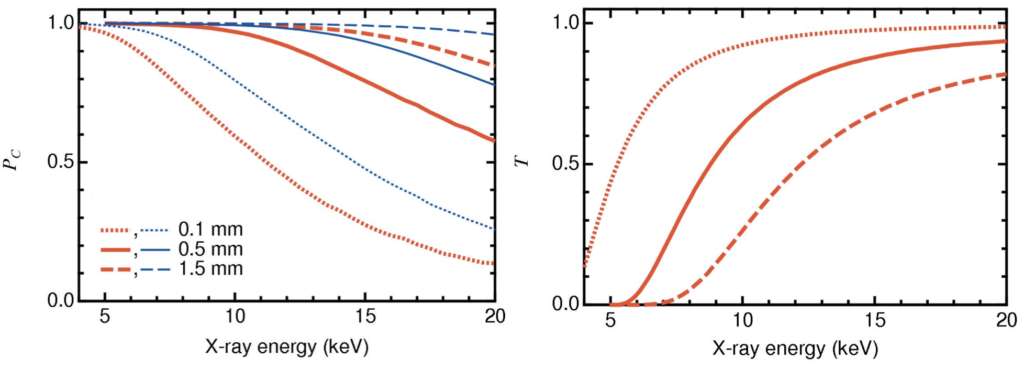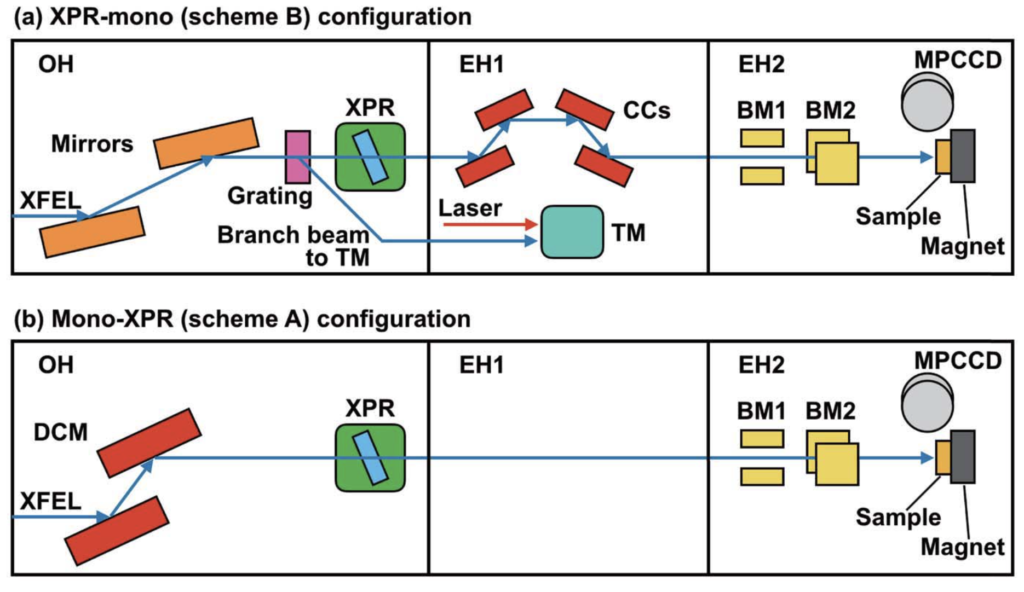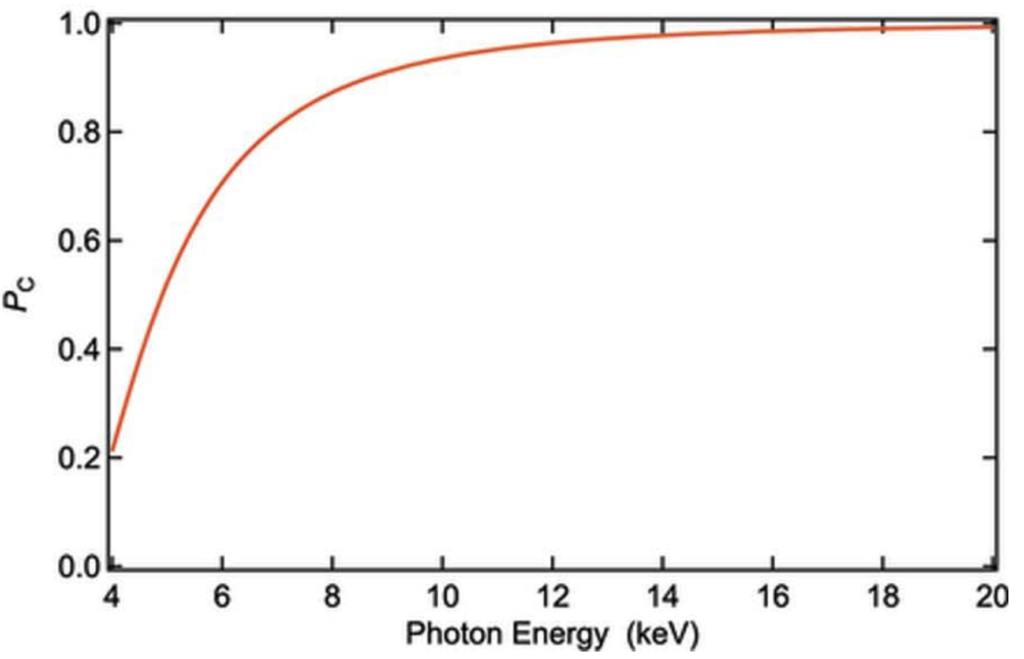XPR (X-ray Phase Retarder)
BL3 OHにはXFELの偏光を制御するためのX線移相子(X-ray phase retarder, XPR)が常設されています。
XPR装置を利用した実験を計画されている場合は、利用可能な波長や偏光条件などについて、課題申請前にこのメールアドレスはスパムボットから保護されています。閲覧するにはJavaScriptを有効にする必要があります。まで必ずお問い合わせください。
参考文献:
M. Suzuki et al., J. Synchrotron Radiat. 21, 466 (2014).
Y. Kubota et al., J. Synchrotron Radiat. 26, 1139 (2019).

XPR装置図
XPR装置には偏光を制御するための3種類のダイヤモンド結晶が備えられています。各ダイヤモンドのパラメータと対応する光子エネルギーを以下に示します。

各ダイヤモンド結晶を用いた際の円偏光度と透過率のX線光子エネルギー依存性の計算値を以下に示します。

円偏光度(左図)と透過率(右図)の光子エネルギー依存性
11.562 keV(PtのL3殻吸収端)における垂直直線偏光度と円偏光度の測定結果はそれぞれ67 %、97%です。

直線偏光度(左図)と円偏光度(右図)のダイヤモンド結晶角度依存性
さらに、従来のモノクロビームをXPRに入射する実験配置に代わり、ピンクビームを入射し、偏光制御後に単色化することも可能です。以下に実験配置例とその際の円偏光度の計算値を示します。

XPRを用いた実験配置例。XPRにピンクビームを入射した後に単色化する場合 (a)とモノクロビームをXPRに入射する場合 (b)。TM: timing monitor; CCs: monochromator composed of channel-cut crystals; BM: beam monitor。

ピンクビームをXPRに入射し、その後単色化した際の円偏光度の計算値
SACLAの場合、ピンクビームを用いることで、タイミングモニターとの併用が可能になります。
XPR (X-ray Phase Retarder)
BL3 OH is permanently equipped with an X-ray phase retarder (XPR) to control the polarization of the XFEL. If you are planning an experiment using the XPR device, please be sure to contact the XFEL Utilization Division for information on the available wavelength and polarization conditions before submitting an assignment.
XPR equipment imagessThe XPR device is equipped with three types of diamond crystals to control polarization. The parameters of each diamond and the corresponding photon energies are shown below.

The calculated values of the X-ray photon energy depending on the degree of circular polarization and the transmittance are shown below for each diamond crystal.

Photon energies depending on circular polarization (pictured left) and transmittance (pictured right)The measurement results of the vertical degree of polarization and the degree of circular polarization at 11.562 keV(L3 shell absorption end of Pt)are 67% and 97% respectively.
Diamond crystal angle dependence of linear polarization (pictured left) and circular polarization (pictured right)In addition, instead of a conventional experimental arrangement in which monochromatic beams are incident on the XPR, it is possible to have a pink beam incident, then convert to a monochromatic beam after the polarization control. The following is an example of an experimental arrangement and the calculated value for the degree of circular polarization.

Example of an experimental arrangement using XPR. It includes when the pink beam is incident on the XPR then it is converted to a monochromatic beam afterwards (a), and when the monochromatic beam is incident on the XPR (b). TM: timing monitor; CCs: monochromator composed of channel-cut crystals; BM: beam monitor.

The calculated circular polarization when the pink beam is incident on the XPR and then converted to a monochromatic beam. With SACLA, using a pink beam enables the use of a timing monitor. References: K. Yamamoto et al., New J. Phys. 21, 123010 (2019).


